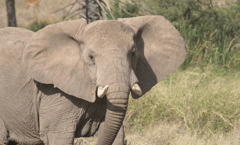Science Note/ Bees and Elephants
Air Date: Week of August 7, 2009

An elephant in Kenya. (Whit Welles)
African elephants often trample farmers’ crops in search of food, but a new fence uses beehives to deter the pachyderms. Living on Earth’s Lisa Song reports on how the elephants’ fear of bees could be the key to helping local farmers.
Transcript
Coming up – a fast-growing plant with a funny name that’s no joke - but first this note on emerging science from Lisa Song.
[BEES BUZZING]
SONG: When it comes to bee stings, it seems that elephants never forget. And that’s the secret behind a new fence that uses beehives to stop elephants from destroying farmer's fields.
[THEME MUSIC]
SONG: For centuries, Africa's largest mammals have roamed the continent in search of food. Local farmers often find their crops trampled and eaten by migrating elephants. To protect their livelihoods, the farmers fight back with dogs, spears, and guns.
A more peaceful solution comes from honeybees. Researchers hung wooden beehives along a wire fence built around one farmer's field in northern Kenya. Any elephant that tried to squeeze past the wire triggered the beehives to swing back and forth. Although they were empty, the moving beehives were enough to send the elephants scurrying away in fear. Pachyderms are protected by their thick skins, but bees can sting elephants around their eyes or inside their trunk.

An elephant in Kenya. (Whit Welles)
After six weeks, the fenced farm suffered half as many elephant raids as a neighboring farm. The elephants ate 90% of the crops from the unprotected farm, while the first farmer collected a normal harvest.
With the success of one fence, plans are underway to build similar fences around 60 other farms. This time, the beehives will hold real honeybees; farmers can even sell the honey to cover the cost of fence construction. In the continuing conflict between wildlife and farming, the bee-fence could help both elephants and humans.
That’s this week’s Note on Emerging Science. I’m Lisa Song.
Links
Researcher Lucy King’s website
Link for original research article (near the bottom of the page)
Living on Earth wants to hear from you!
Living on Earth
62 Calef Highway, Suite 212
Lee, NH 03861
Telephone: 617-287-4121
E-mail: comments@loe.org
Newsletter [Click here]
Donate to Living on Earth!
Living on Earth is an independent media program and relies entirely on contributions from listeners and institutions supporting public service. Please donate now to preserve an independent environmental voice.
NewsletterLiving on Earth offers a weekly delivery of the show's rundown to your mailbox. Sign up for our newsletter today!
 Sailors For The Sea: Be the change you want to sea.
Sailors For The Sea: Be the change you want to sea.
 The Grantham Foundation for the Protection of the Environment: Committed to protecting and improving the health of the global environment.
The Grantham Foundation for the Protection of the Environment: Committed to protecting and improving the health of the global environment.
 Contribute to Living on Earth and receive, as our gift to you, an archival print of one of Mark Seth Lender's extraordinary wildlife photographs. Follow the link to see Mark's current collection of photographs.
Contribute to Living on Earth and receive, as our gift to you, an archival print of one of Mark Seth Lender's extraordinary wildlife photographs. Follow the link to see Mark's current collection of photographs.
 Buy a signed copy of Mark Seth Lender's book Smeagull the Seagull & support Living on Earth
Buy a signed copy of Mark Seth Lender's book Smeagull the Seagull & support Living on Earth

